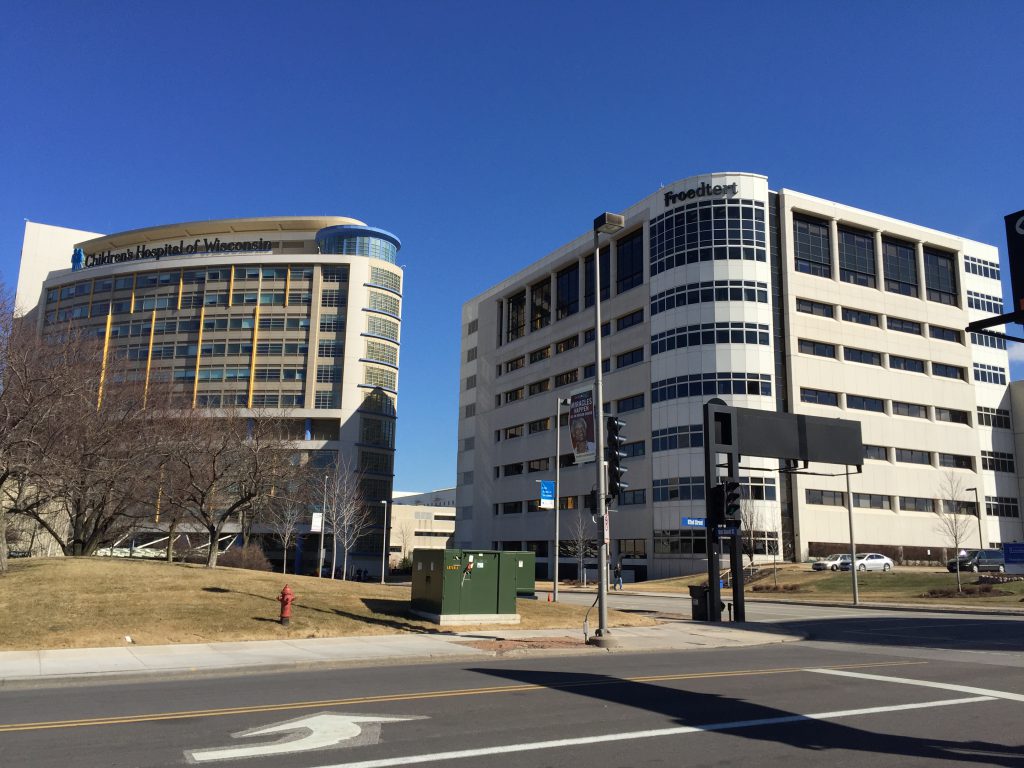Hospitals Get Even More Stingy on Charity Care
Hospitals in state and metro area have further cut the percent of revenue for this.

Children’s Hospital of Wisconsin and Froedtert. File photo by Aalvarez89 / (CC BY-SA)
“Charity services are an important indicator of a hospital’s fulfillment of its charitable obligations.”
So says the most recent Uncompensated Health Care Report by the Wisconsin Hospital Association (WHA). But to judge by statistics in the report, hospitals across Wisconsin and in Milwaukee County have little commitment to charity.
Charity care for all reporting hospitals averaged just 0.7% — well less than a penny per dollar — of total gross patient revenue in 2023. That was the same average, 0.7%, as in 2022 and 2021, but is down by nearly a third from the years 2018 through 2020, when hospitals spent 1% of their total revenue on charity care, annual reports by the WHA show.
The total amount of charity care given in 2023, $627 million, sounds big until measured against the total gross patient revenue for all Wisconsin hospitals, which was an astounding $89.5 billion.
Across the state the amount of charitable care provided ranged from 0% to 5.3% of gross revenue, but as the average is .07%, a huge number of hospitals are well below even that figure.
That pattern can be seen in metro Milwaukee, where three hospitals located in the city have a higher percentage of total revenue going to charity care: Ascension St. Francis hospital on the city’s South Side devoted 3.5% of total gross patient revenue to charity care, tops in the metro area, and Ascension St. Joseph’s on the city’s North Side devoted 1.4% to charity care, as did Aurora St. Luke’s on the South Side.
By contrast, the Ascension-connected Orthopedic Hospital of Wisconsin in Glendale devoted 0% its revenue to charity care, and the Ascension hospitals in Menomonee Falls and Waukesha were both at 0.1%.
These differences become even greater when you look at the WHA’s report for total uncompensated care, which includes charity care and bad debt: St. Francis and St. Joseph are in lower-income neighborhoods and devoted 4.9% and 2.6% of their gross patient revenue to uncompensated care, while the Ascension Menomonee Falls hospital devoted just 0.1% of its budget to uncompensated care in 2023.
Those numbers may help explain why chains like Ascension Wisconsin have cut back services at its less profitable city hospitals including its labor and delivery services at St. Francis and its cardiac catheterization labs at both St. Francis and St. Joseph hospitals.
Ascension’s mission statement declares that “we commit ourselves to serving all persons with special attention to those who are poor and vulnerable.” And it has dozens of foundations that receive charitable donations. But it has built a vast financial empire, including $18 billion in cash reserves and $41 billion in investments, helped by decisions to slash staff, services and costs in Wisconsin and other states.
Also at the bottom in charity care was Children’s Wisconsin, which devoted 0.0% of its revenue to charity care in 2023, according to the WHA report. Even when its bad debt is added to that, its total uncompensated care was 0.4% of total patient revenue. The hospital has in the past defended itself, telling Urban Milwaukee that children are in a different situation as “the vast majority” in the state have some kind of coverage from public or private sources, so charity care typically isn’t needed.
Yet in December 2023 Children’s shut down a pediatric clinic on the city’s North Side, one of the poorest and least healthy neighborhoods in the nation. It received considerable criticism for the decision, with critics charging it contradicted Children’s motto, “Kids deserve the best.”
Children’s insisted it had not made the decision for financial reasons, noting “Well over 50 percent of our patients every year receive some form of Medicaid coverage.”
But as a study by the respected health care analyst KFF found, private insurers pay way more than Medicaid, nearly double the rate for all hospital services. By closing the northside clinic, where 95% of patients are on Medicaid, Children’s could lower its 50% system-wide figure.
Meanwhile it has grown its wealth to the point where it has $3.2 billion in combined net assets, including $1.2 billion in publicly traded securities and an endowment of $1.089 billion, its tax forms show.
Besides Ascension the other major health care chain in the metro area is Aurora Health Care, which has spent slightly more than the state average on charity care. Aurora St Luke’s (1.4% of total patient revenue) and Aurora Mount Sinai (1.3%) spent the most on charity care among its metro-area hospitals, with only Aurora Medical Center in Hartford below the state average at 0.5%.
But it remains to be seen if that will change now that the Advocate Aurora chain has been bought by the bigger chain, North Carolina-based Atrium Health. Moreover, even if Aurora is more generous than the average hospital, it is unlikely to be giving more charity care than the value of its tax exemption as a nonprofit. A recent study by Kaiser Family Foundation found that hospitals nationally provided $16 billion in charity care in 2020, which was far less than the estimated $28 billion value of their federal, state and local tax exemptions.
Hospitals have argued this doesn’t take into account all the community benefits they provide. But the study also didn’t take into account charitable donations received and other benefits from government, including exemptions from the federal unemployment tax and interest expense savings from issuing tax-exempt bonds, as a new report noted. All told, it estimated the total benefits for hospitals at more than $37 billion, compared to $16 billion in charity care.
Once upon a time, as recently as the early 1990s, a hospital like St. Mary’s in Milwaukee was run by a nun who took the vow of poverty and was paid $1 a year. Back then the hospital didn’t tally the “community benefits” it offered because everything it did fell into that category. That’s what hospitals did.
Today the Ascension Chain has seven top executives who together earn more than $40 million per year and keep a close eye on any uncompensated care that might reduce the chain’s net income. To judge by the latest WHA report, they are doing that pretty successfully in Wisconsin.
If you think stories like this are important, become a member of Urban Milwaukee and help support real, independent journalism. Plus you get some cool added benefits.
Murphy's Law
-
MPS, City Feud Over Paying School Resource Officers
 Feb 12th, 2025 by Bruce Murphy
Feb 12th, 2025 by Bruce Murphy
-
Republicans Unfazed by Musk, Grothman Says
 Feb 5th, 2025 by Bruce Murphy
Feb 5th, 2025 by Bruce Murphy
-
Wisconsin Congress Members Condemn Musk Takeover
 Feb 4th, 2025 by Bruce Murphy
Feb 4th, 2025 by Bruce Murphy






















“…provided $16 billion in charity care in 2020, which was far less than the estimated $28 million (billion?) value of their federal, state and local tax exemptions.”
How is it that these thieves continue to be tax exempt as they haul in billions and cut services to the most needy? Outrageous…
Yes, Claude, should be $28 billion, thanks for catching that.
I heard from an employee that Childrens doesn’t want to pay staff to keep the main entrance open, now folks are directed to a smaller entrance in the clinics building.
Excellent article and the impact on increasing health disparities significant. It would be refreshing for governmental leader to take this issue on and tax or monitor to assure charity care goals are negotiated and met. Thank you for digging in and writing this article.
Thank goodness for the over 20 greater Milwaukee area FREE clinics where volunteer health clinicians, nurses and staff offer physical, dental, and mental health care services to those without insurance, undocumented people, the homeless.
The Free Community Clinic Collaborative (FC3) clinics rely heavily on volunteer support from physicians, dentists, nurses, nurse practitioners, medical assistants and physician assistants, as well as medical student interns, to provide care to those in need. A recent analysis indicates that with enough volunteers, FC3 clinics have the capacity to provide an additional 20,000 clinic visits annually. If you have free time, especially if you’re a retired health care clinician (MD/DO/PA/NP/RN/LPN/DDS) and want to restore a sense of purpose in your life, consider volunteering a few hours every month! http://www.wifc3.org/
mpbrhar practices what he states. I am well aware of the most likely 1000’s of volunteer hours he has provided to the Milwaukee area communities for a number of free clinics providing medical services throughout his long career. Thanks
I am surprised there is no mention of Froedtert as they are central to the care of SE Wisconsin.
gwarzyn: Thank you!
mkebrew: Conspicuous omission of any mention of Froedtert. How much charity care do they provide, Bruce Murphy?
Ascension is particularly egregious in getting rid of any and all charity care: obstetrics in some form or another at St. Francis, St. Josephs and St. Mary’s – all in Milwaukee.
Repeated and continued efforts to close St. Joseph’ completely depriving the entire west and north sides of Milwaukee of any hospital other than Froedert..
the nuns are spinning in their graves.
It is stunning how greedy the fake “non-profit” health care executives are.
Mu understanding is that when Ascension took over St. Mary’s they fired/laid off 15-20% of the nursing staff. I do not remember where I heard that and it could be incorrect or an exaggeration, but the lack of nursing staff could explain some of the weird stories about care that I have heard.
just a reminder that “non-profit doesn’t mean NO profit” …they steal plenty of money, and try to appear like saints.
Wish states/feds would ever call a spade a spade and put an end to these loopholes.
Thank you, Bruce. Something must be done to hold these institutions accountable. Your reporting is a good first step.
As a level 1 trauma center doesn’t Froedtert have to take everyone?
I really don’t know.